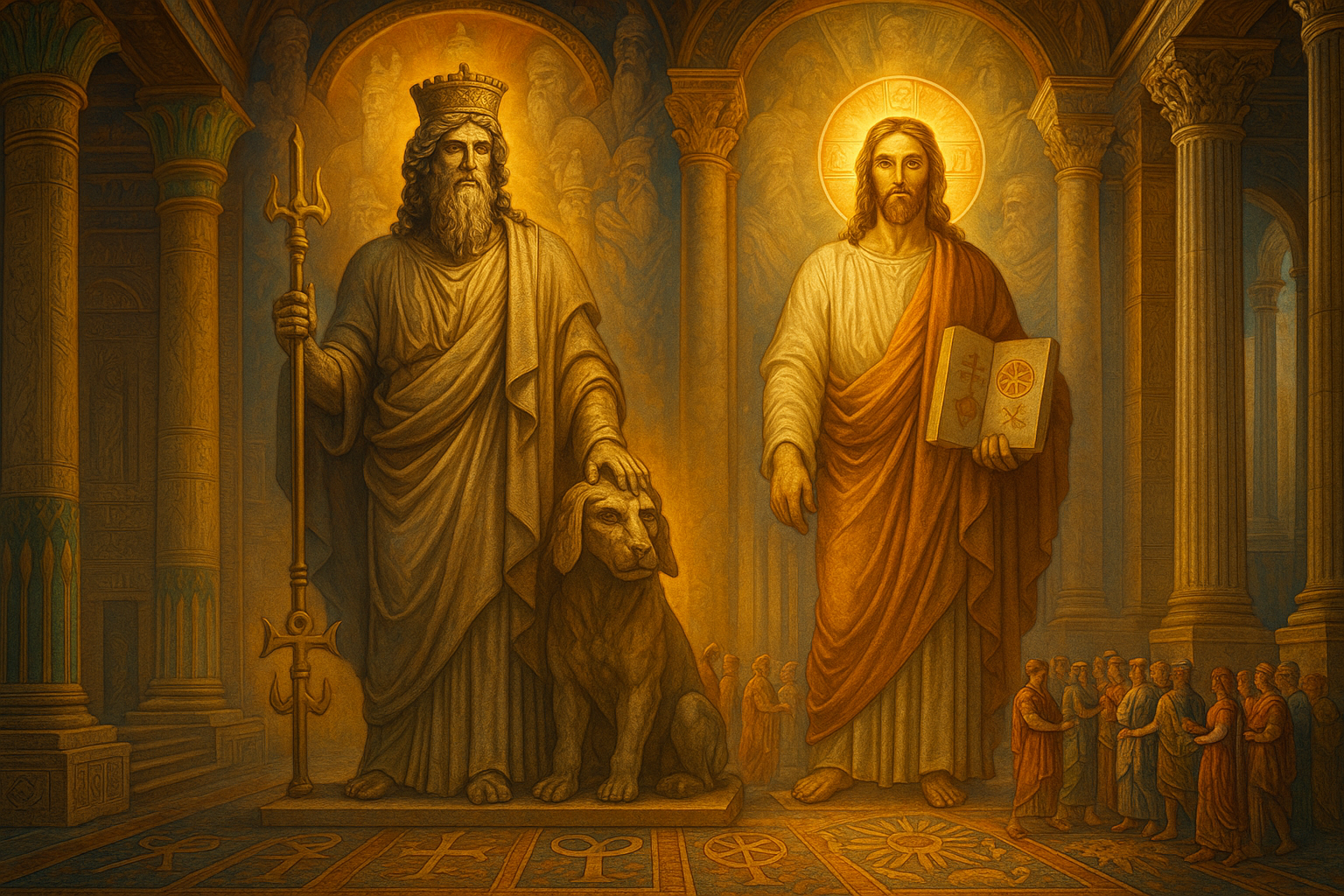History teaches us that religious identity is never static. It is a fluid negotiation of power, culture, and community. In the ancient world, few examples better illustrate this than the State-sanctioned creation and adaptation of gods like Serapis and Jesus the Christ. These figures did not emerge in cultural vacuums. Rather, they were carefully crafted through syncretism—an intricate blending of belief systems—to unify fractured empires and legitimize rulers.
Serapis: The Politics of Invention
When Ptolemy I Soter, a Macedonian general of Alexander the Great, assumed power in Egypt around 305 BC, he faced a unique dilemma: how to govern an empire split between native Egyptians and Hellenistic (Greek) settlers. His solution was Serapis, a deity forged not from faith, but from political necessity. Serapis was a hybrid god, combining elements of the Egyptian Osiris and Apis with Greek gods such as Zeus, Hades, and Asclepius. He had the appearance of a Greek ruler but bore the attributes of Egyptian underworld gods, complete with a grain basket (modius) atop his head symbolizing abundance and fertility (Murphy, 2021).
Ptolemy introduced Serapis not just to unite religious traditions, but to also reframe the State itself. As Dawson (2014) notes, the cult of Serapis allowed Greeks in Alexandria to claim a spiritual stake in their new home while pacifying Egyptians by linking Serapis with their revered Osiris-Apis tradition. Temples like the Serapeum in Memphis bore dual architecture and symbolism, housing statues of both Greek philosophers and Egyptian sphinxes – visual testaments to a calculated fusion of cultures.
Yet, Serapis was not readily accepted by all. Despite state sponsorship, his cult struggled to win widespread Egyptian devotion. Egyptians often saw him as a “counterfeit” version of their own gods, while Greeks viewed him as a legitimizing tool of Ptolemaic rule (Murphy, 2021). His success lay not in winning hearts, but in stabilizing a divided polity.
Constantine: The Syncretist Emperor
Fast forward to the 4th century AD. Constantine the Great stood atop a similarly divided empire, this time between pagans and a growing Christian (pagan Hellenistic Jew) population. Like Ptolemy before him, Constantine saw in religion a powerful tool for imperial unity. But where Ptolemy invented a god, Constantine rebranded a religion.
Though Constantine is often hailed as Christianity’s champion, his policy was less about theology and more about control. Constantine maintained tolerance toward traditional pagan practices while promoting the Christian religion as the new ideological glue of the empire. His edicts did not immediately ban pagan sacrifices, as some scholars have claimed, but instead reflected a careful balancing act between religious communities (Errington, 1988).
To ease the transition, Constantine employed a similar syncretic strategy. Christian holidays were aligned with pagan festivals; most famously, Christmas with Saturnalia. Temples once dedicated to pagan deities were rededicated to Christian saints. Even the Jesus character’s image gradually took on the visual likeness of Roman gods like Sol Invictus, reinforcing familiarity through resemblance.
Syncretism as Statecraft
Both Ptolemy and Constantine used religious syncretism to perform a crucial function: to unite disparate populations under a single cultural umbrella without resorting to outright repression. Their approach was pragmatic, not pious.
For Ptolemy, Serapis offered a symbolic common ground between colonizers and the colonized. For Constantine, the Christian religion provided a unified moral code and institutional framework adaptable to Roman governance. In both cases, religion was not imposed from below by prophets or mystics, but shaped from above by rulers wielding “divine authority” as an extension of political will.
This strategy resonates with modern attempts at multicultural governance. From India’s policy of religious pluralism to the inclusion of interfaith prayers in U.S. civic ceremonies, states continue to use symbolic fusion to forge unity out of diversity. I suppose it is on us to be on the look out for another Constantine or Ptolemy I, and their new Jesus Serapis.
Learn From History
Religious syncretism in antiquity wasn’t merely theological, it was a form of imperial strategy. Serapis and Jesus, though born of different eras, embody the same impulse: to craft religious meaning in the service of social cohesion. One would then think, for example, that the Jesus character would shriek at such a masterful sociopolitical opportunity to rule an empire, seeing as how in John 6:15, when he “perceived that they would come and take him by force, to make him a king, he departed again into a mountain himself alone.” Why, once Constantine takes office, does Jesus change his mind? Whether through the merging of Isis and Demeter or the transformation of Saturnalia into Christmas, empires have always sought to anchor their authority in what is to be thought of as “sacred.”
I believe that we, as we move through our present world, can learn from this history. The blending of “faiths” is not just a practice of the past, it’s a living process, and one that continues to define how we share space, stories, and ultimately, what we revere as supposedly “divine.”
References
Dawson, D. (2014). A Cult of Fusion. Vulcan Historical Review, 18.
Errington, R. M. (1988). Constantine and the Pagans. Greek, Roman and Byzantine Studies, 29(3), 309–314.
Murphy, L. (2021). Beware Greeks Bearing Gods: Serapis as a Cross-Cultural Deity. Amphora, 2, 29–44.



